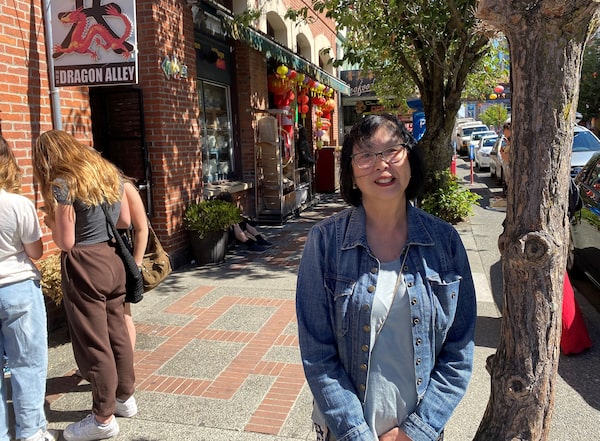
University of Victoria Chinese culture expert Grace Wong Sneddon, Department of Art History & Visual Studies, in Victoria on Sept. 3.Dirk Meissner/The Canadian Press
The first day of school in Victoria one hundred years ago marked the start of a student strike over segregation that helped Chinese-Canadians solidify their place in a country that was not always welcoming, say historians and cultural experts.
It was on Sept. 5, 1922, that the British Columbia capital’s more than 200 Chinese-Canadian students refused to attend Victoria School Board mandated Chinese-only schools, launching a one-year student strike that eventually saw the board reverse its segregationist policy in time for the start of class in 1923.
A Monday march to commemorate the student strike was set to start at the elementary school that still bears the name of George Jay, the school board chairman in 1922, and was scheduled to end at the nearby Kings Road park, which was the planned location for the Chinese-only schools.
“We talk about history and we talk about Chinese-Canadian history, well, this to me is the defining moment,” said Grace Wong Sneddon, a University of Victoria Chinese culture and Asian identity expert who grew up in Victoria and went to public school there.
“Up to this point, there were Canadians, and there were Chinese,” she said in an interview. “They didn’t go together. But this moment, this act of defiance and this demonstrated piece of agency, I think, really set the moment and made Chinese-Canadians as a concept and a reality. That is so cool.”
Ms. Wong Sneddon said Chinese-Canadians endured racist policies and racial stereotypes, but the community united and drew the line at the proposal to place their children in segregated schools.
“The parents said education is too important to our kids and if we don’t stand up now, future generations will be affected,” she said. The whole community supported this move: clan-associations, county-associations, merchants, rich, poor, individuals, families led by the Chinese Consolidated Benevolent Association.”
Ms. Wong Sneddon said the local Chinese-Canadian community hired two teachers from the United States who conducted classes throughout the year to ensure the students did not fall behind as the strike wore on.
The Greater Victoria School Board issued a formal apology earlier this month for the 1922 segregation policy, and current board members are expected to attend Monday’s anniversary march.
The school board also plans to erect a plaque honouring the student strike.
“Among a long list of historic wrongs perpetuated against the Chinese community in Victoria, this stands out as a particularly dark incident for our school district,” current board chairman Ryan Painter said in a statement. “The racist discrimination that led to this act is unacceptable and viewed with regret.”
Former Victoria mayor Alan Lowe, who is Chinese-Canadian, issued a statement saying the actions of the students 100 years ago helped pave the path for students like him to excel at public schools decades later.
“What started as a school boycott became a protest movement for equality which brought together the Chinese community locally, regionally and nationally from county and clan-associations to individuals,” said Mr. Lowe, who is also chairman of the Victoria Chinatown Museum Society.
Tim Stanley, a University of Ottawa emeritus professor who studied the history of racism in Canada, said the Victoria student strike was a monumental event in establishing Canada’s Chinese-Canadian community.
He wrote a book about the strike entitled Contesting White Supremacy: School Segregation, Anti-Racism and the making of Chinese-Canadians, and said he planned to attend the march commemorating what he described as a pivotal time for the community.
“This is the moment where the Chinese say, ‘Look, we’re Canadian. We’ve been here since before the country existed and we’re not going to take it any more,’ ” he said of the strike. “‘We’re prepared to do this for our rights.’”
We have a weekly Western Canada newsletter written by our B.C. and Alberta bureau chiefs, providing a comprehensive package of the news you need to know about the region and its place in the issues facing Canada. Sign up today.